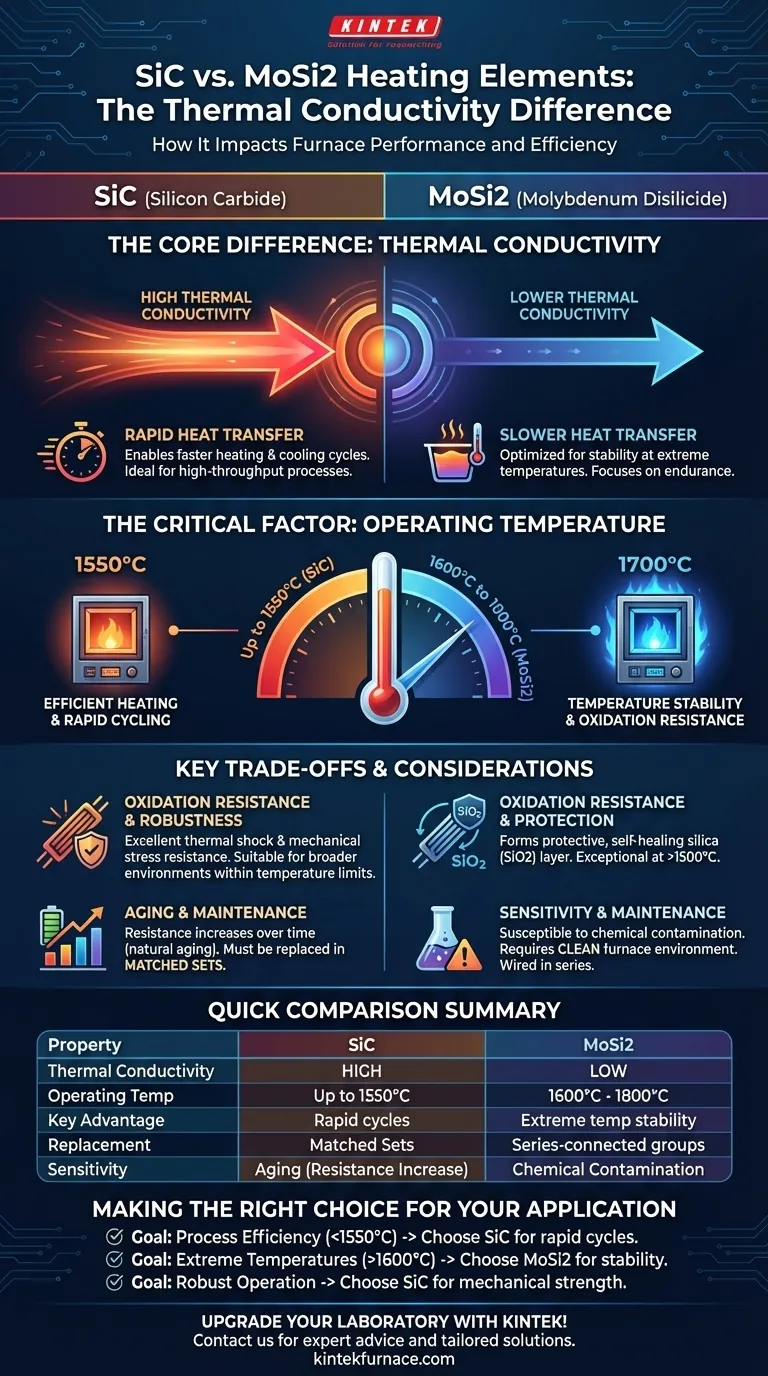In short, silicon carbide (SiC) heating elements possess a significantly higher thermal conductivity than molybdenum disilicide (MoSi2) elements. This fundamental difference means SiC can transfer heat more efficiently, enabling faster heating and cooling cycles within a furnace. MoSi2, with its lower thermal conductivity, is engineered for a different purpose: unparalleled stability at extreme temperatures.
The choice between SiC and MoSi2 is rarely about thermal conductivity alone. The decision hinges on your required operating temperature. SiC excels in rapid, efficient heating up to about 1550°C, while MoSi2 is the definitive choice for applications demanding stability at temperatures above 1600°C.
The Role of Thermal Conductivity
Thermal conductivity dictates how quickly a material can transfer heat from its core to its surface and then into the surrounding environment. This property directly impacts furnace performance and process efficiency.
SiC: High Conductivity for Rapid Cycling
Silicon carbide's excellent thermal conductivity allows it to dissipate heat energy into the furnace chamber almost immediately.
This property is ideal for processes that benefit from fast heat-up and cool-down times. By reducing cycle times, SiC elements can significantly improve throughput and overall process efficiency.
MoSi2: Lower Conductivity for Extreme Temperatures
Molybdenum disilicide has a lower thermal conductivity. While this means it transfers heat less rapidly than SiC, its primary advantage lies elsewhere.
MoSi2 elements are designed for stability and longevity at extreme temperatures (up to 1800°C) where SiC elements would fail. Their performance is defined by high-temperature endurance rather than the speed of heat transfer.
Beyond Conductivity: A Deeper Comparison
Focusing only on thermal conductivity provides an incomplete picture. The materials have fundamentally different properties that make them suitable for distinct applications.
The Critical Factor: Operating Temperature
Your furnace's target temperature is the most important factor in your decision.
- SiC elements are typically used for furnace temperatures up to 1550°C (with an element surface temperature of ~1600°C).
- MoSi2 elements are required for higher temperature work, operating reliably in furnaces from 1600°C to 1700°C, and even up to 1800°C in some models.
Oxidation and Atmospheric Resistance
How the element survives in a hot, oxidizing environment is crucial for its lifespan.
MoSi2 excels in this area by forming a protective, self-healing layer of silica (SiO2) on its surface at high temperatures. This gives it exceptional oxidation resistance above 1500°C.
SiC also offers excellent resistance to thermal shock and mechanical stress, making it a robust choice for a broader range of environments, but within its lower temperature limit.
Understanding the Trade-offs
Every engineering choice involves compromises. Understanding the potential downsides of each material is key to avoiding costly mistakes.
SiC: Aging and Replacement
The electrical resistance of SiC elements increases over time with use. This is a natural aging process.
When one element fails, you cannot simply replace the single unit. Because its resistance will be different from the older elements, it will create an imbalance. Therefore, SiC elements must be replaced in matched sets or series-connected groups.
MoSi2: Sensitivity to Contamination
While MoSi2 elements can have a very long service life, they are more susceptible to damage from chemical contamination.
Proper furnace maintenance is critical. Failure to keep the furnace chamber clean can lead to premature element failure, negating their potential for longevity. They are also wired in series, meaning a single failure takes down the entire circuit.
Making the Right Choice for Your Application
To select the correct element, you must align the material's properties with your primary operational goal.
- If your primary focus is process efficiency below 1550°C: Choose SiC for its high thermal conductivity, which enables rapid heating and cooling cycles.
- If your primary focus is achieving extreme temperatures above 1600°C: MoSi2 is the only suitable choice, offering unmatched stability and oxidation resistance in this range.
- If your primary focus is robust operation with predictable maintenance: SiC offers superior mechanical strength and a more straightforward, albeit more frequent, replacement schedule.
Ultimately, selecting the right heating element requires a clear understanding of your process parameters, especially your target temperature.
Summary Table:
| Property | SiC Heating Element | MoSi2 Heating Element |
|---|---|---|
| Thermal Conductivity | High | Low |
| Operating Temperature | Up to 1550°C | 1600°C to 1800°C |
| Key Advantage | Rapid heating/cooling cycles | Extreme temperature stability |
| Replacement Requirement | Matched sets | Series-connected groups |
| Sensitivity | Aging increases resistance | Chemical contamination |
Upgrade your laboratory with the right heating element! Leveraging exceptional R&D and in-house manufacturing, KINTEK provides diverse laboratories with advanced high-temperature furnace solutions. Our product line, including Muffle, Tube, Rotary Furnaces, Vacuum & Atmosphere Furnaces, and CVD/PECVD Systems, is complemented by our strong deep customization capability to precisely meet unique experimental requirements. Whether you need SiC for efficiency or MoSi2 for extreme temperatures, we can help optimize your processes. Contact us today for expert advice and tailored solutions!
Visual Guide

Related Products
- Silicon Carbide SiC Thermal Heating Elements for Electric Furnace
- Vacuum Heat Treat Furnace with Ceramic Fiber Liner
- Molybdenum Vacuum Heat Treat Furnace
- Laboratory Muffle Oven Furnace with Bottom Lifting
- Split Multi Heating Zone Rotary Tube Furnace Rotating Tube Furnace
People Also Ask
- What temperature ranges are recommended for SiC versus MoSi2 heating elements? Optimize Your Furnace Performance
- What are the operational characteristics of SiC heating elements? Maximize High-Temp Performance and Efficiency
- What is the operating temperature of SiC? Unlock Reliable Performance Up to 1600°C
- What are the advantages of silicon carbide heating elements in dental furnaces? Boost Zirconia Sintering Quality
- What types of heating elements are commonly used in drop tube furnaces? Find the Right Element for Your Temperature Needs



















